Comparison of Efficiency-Based Optimal Load Distribution for Modular SSTs with Biologically Inspired Optimization Algorithms
Abstract
:1. Introduction
2. Problem Formulation
2.1. Ant Lion Optimizer
2.1.1. Operators for ALO
Random Walks for Ants
Trapping in Antlion Pits
Building Traps
Sliding Ants towards Antlion
Catching Prey and Rebuilding Pit
Elitism
2.2. Objective Function
3. Simulation and Results
4. Conclusions and Future Recommendations
Author Contributions
Funding
Conflicts of Interest
Abbreviations
| DER | Distributed energy resources |
| LFT | Low frequency transformer |
| cumSm | Cumulative sum |
| r(t) | Stochastic function |
| t | Step of random walk |
| Rand | Random number generator |
| Mant | Parameters of each solution |
| Minimum of random walks in ith variable | |
| Maximum of random walks in ith variable | |
| Maximum ith variable in tth iteration. | |
| Minimum ith variable in tth iteration. | |
| WAt | Random walk around the antlion selected by the roulette wheel |
| WEt | Random walk around elite at the tth iteration |
| Pjn | Input of SST |
| Poj | Output of each SST |
| (a, b & c ) | Constants from Input/output quadratic equation |
| PD | Load demand |
| Minimum and maximum output power limitations | |
| Maximum output power limitations. | |
| Lagrangian constant | |
| Total input power of all SSTs | |
| Efficiency of jth SST | |
| Coefficients for efficiency and loading graph | |
| Loj | Loading capability of the graph |
| pin | Input power of SST |
| Pmin | Minimum power handling capability of SST. |
| Pmax | Maximum power handling capability of SST. |
| HFT | High frequency transformer |
| DER | Distributed energy resources |
| LFT | Low frequency transformer |
References
- McPherson, S.S. (Ed.) War of the Currents: Thomas Edison vs. Nikola Tesla; Twenty-First Century: Minneapolis, MN, USA, 2012. [Google Scholar]
- Davidson, C. Thomas Edison vindicated—The resurgence of DC in MV and HV power grids. In Proceedings of the 22nd European Conference on Power Electronics and Applications (EPE’20 ECCE Europe), Virtual, 7–11 September 2020. [Google Scholar]
- Tahir, H.; Lee, J.S.; Kim, R.Y. Efficiency evaluation of the microgrid for selection of common bus using copula function-based efficiency curves of the converters. Sustain. Energy Technol. Assess. 2021, 48, 101621. [Google Scholar] [CrossRef]
- Gomez-Exposito, A. The Unstoppable Changing of the Electricity Guard [Commentary]. IEEE Technol. Soc. Mag. 2017, 36, 30–33. [Google Scholar] [CrossRef]
- Zhang, G.; Zhang, B.; Li, Z. A Brief History of Power Electronics Converters. In Designing Impedance Networks Converters; Springer International Publishing AG: Cham, Switzerland, 2018; pp. 1–6. [Google Scholar] [CrossRef]
- Zhang, G.; Li, Z.; Zhang, B.; Halang, W.A. Power electronics converters: Past, present and future. Renew. Sust. Energy Rev. 2018, 81, 2028–2044. [Google Scholar] [CrossRef]
- Korytowski, M. Uno Lamm: The Father of HVdc Transmission [History]. IEEE Power Energy Mag. 2017, 15, 92–102. [Google Scholar] [CrossRef]
- Chinnathambi, N.D.; Nagappan, K.; Samuel, C.R.; Tamilarasu, K. Internet of things-based smart residential building energy management system for a grid-connected solar photovoltaic-powered DC residential building. Int. J. Energy Res. 2022, 46, 1497–1517. [Google Scholar] [CrossRef]
- Gelani, H.E.; Dastgeer, F.; Siraj, K.; Nasir, M.; Niazi, K.A.K.; Yang, Y. Efficiency Comparison of AC and DC Distribution Networks for Modern Residential Localities. Appl. Sci. 2019, 9, 582. [Google Scholar] [CrossRef] [Green Version]
- Gelani, H.E.; Nasir, M.; Dastgeer, F.; Hussain, H. Efficiency comparison of alternating current (AC) and direct current (DC) distribution system at residential level with load characterization and daily load variation. Proc. Pak. Acad. Sci. 2017, 54, 111–118. [Google Scholar]
- Ahmad, F.; Dastgeer, F.; Gelani, H.E.; Khan, S.; Nasir, M. Comparative analyses of residential building efficiency for AC and DC distribution networks. J. Bull. Pol. Acad. Sci. 2021, 69, e136732. [Google Scholar] [CrossRef]
- Rasheed, A.; Khan, S.; Gelani, H.E.; Dastgeer, F. AC vs. DC Home: An Efficiency Comparison. In Proceedings of the International Symposium on Recent Advances in Electrical Engineering (RAEE), Islamabad, Pakistan, 28–29 August 2019; Volume 4, pp. 1–6. [Google Scholar]
- Gerber, D.L.; Vossos, V.; Feng, W.; Marnay, C.; Nordman, B.; Brown, R. A simulation-based efficiency comparison of AC and DC power distribution networks in commercial buildings. Appl. Energy 2018, 210, 1167–1187. [Google Scholar] [CrossRef] [Green Version]
- Gelani, H.E.; Dastgeer, F. Efficiency Analyses of a DC Residential Power Distribution System for the Modern Home. J. Adv. Electr. Comput. Eng. 2015, 15, 135–142. [Google Scholar] [CrossRef]
- Mishra, D.K.; Ghadi, M.J.; Li, L.; Hossain, M.J.; Zhang, J.; Ray, P.K.; Mohanty, A. A review on solid-state transformer: A breakthrough technology for future smart distribution grids. Int. J. Electr. Power Ener. 2021, 133, 107255. [Google Scholar] [CrossRef]
- Hunziker, C.; Lehmann, J.; Keller, T.; Heim, T.; Schulz, N. Networks, Sustainability assessment of novel transformer technologies in distribution grid applications. J. Sust. Energy Grids Netw. 2020, 21, 100314. [Google Scholar] [CrossRef]
- Rødal, G.L.; Pushpalatha, Y.V.; Peftitsis, D. Design Evaluation of Medium-Voltage and High-Power Modularized DC/DC Converters with SiC MOSFETs. In Proceedings of the 23rd European Conference on Power Electronics and Applications (EPE’21 ECCE Europe), Ghent, Belgium, 6–10 September 2021. [Google Scholar]
- Sanchez, S.; Molinas, M. Degree of influence of system states transition on the stability of a DC microgrid. J. IEEE Trans. Smart Grid. 2014, 5, 2535–2542. [Google Scholar] [CrossRef]
- Baliga, B.J. Chapter 7—Gate Drive Circuit Design. In The IGBT Device; Baliga, B.J., Ed.; William Andrew Publishing: Amsterdam, The Netherlands, 2015; pp. 193–203. [Google Scholar]
- Shair, J.; Li, H.; Hu, J.; Xie, X. Power system stability issues, classifications and research prospects in the context of high-penetration of renewables and power electronics. J. Renew. Sust. Energy Rev. 2021, 145, 111111. [Google Scholar] [CrossRef]
- Dastgeer, F.; Gelani, H.; Ali, F.; Javed, Z. Enhancing the Energy/Power Efficiency of a DC Distribution Grid for Residential Buildings via Modular Architecture of DC/DC Solid State Transformers. J. Adv. Sci. Technol. Eng. Syst. 2018, 3, 288–297. [Google Scholar] [CrossRef] [Green Version]
- Tingfang, Y.; Ting, T.O. Methodological Priority List for Unit Commitment Problem. In Proceedings of the 2008 International Conference on Computer Science and Software Engineering, Wuhan, China, 12–14 December 2008; Volume 1, pp. 176–179. [Google Scholar]
- Raj, V.M.; Chanana, S. Analysis of unit commitment problem through Lagrange relaxation and priority listing method. In Proceedings of the 6th IEEE Power India International Conference (PIICON), Delhi, India, 5–7 December 2014; pp. 1–6. [Google Scholar]
- Skolfield, J.K.; Escobedo, A.R. Operations research in optimal power flow: A guide to recent and emerging methodologies and applications. Eur. J. Oper. Res. 2022, 300, 387–404. [Google Scholar] [CrossRef]
- Travers, D.L.; Kaye, R.J. Dynamic dispatch by constructive dynamic programming. IEEE Trans. Power Syst. 1998, 13, 72–78. [Google Scholar] [CrossRef]
- Chaitanya, S.N.V.S.K.; Ashok Bakkiyaraj, R.; Venkateswara Rao, B. Technical Review on Optimal Reactive Power Dispatch with FACTS Devices and Renewable Energy Sources. In Lecture Notes in Electrical Engineering; Springer: Singapore, 2022; pp. 185–194. [Google Scholar]
- Naderi, E.; Narimani, H.; Pourakbari-Kasmaei, M.; Cerna, F.V.; Marzband, M.; Lehtonen, M. State-of-the-Art of Optimal Active and Reactive Power Flow: A Comprehensive Review from Various Standpoints. Processes 2021, 9, 1319. [Google Scholar] [CrossRef]
- Rugthaicharoencheep, N.; Boonthienthong, M.; Charlangsut, A. Optimal Reactive Power Control in Power System with Particle Swarm Optimization Technique. Appl. Mech. Mater. 2019, 891, 246–252. [Google Scholar] [CrossRef]
- Mouassa, S.; Bouktir, T. Artificial Bee Colony Algorithm for Discrete Optimal Reactive Power Dispatch. In Proceedings of the International Conference on Industrial Engineering and Systems Management (IESM), Seville, Spain, 21–23 October 2015; pp. 654–662. [Google Scholar]
- Boussaïd, I.; Lepagnot, J.; Siarry, P. A survey on optimization metaheuristics. Inf. Sci. 2013, 237, 82–117. [Google Scholar] [CrossRef]
- Zedadra, O.; Guerrieri, A.; Jouandeau, N.; Spezzano, G.; Seridi, H.; Fortino, G. Swarm intelligence-based algorithms within IoT-based systems: A review. J. Parallel Distrib. Comput. 2018, 122, 173–187. [Google Scholar] [CrossRef]
- Dokeroglu, T.; Sevinc, E.; Kucukyilmaz, T.; Cosar, A. A survey on new generation metaheuristic algorithms. Comput. Ind. Eng. 2019, 137, 106040. [Google Scholar] [CrossRef]
- Reddy, A.V.S.; Reddy, Y.P.K.; Reddy, B.B.R. Application of ALO to Economic Load Dispatch Without Network Losses for Different Conditions. In Proceedings of the 2nd IEEE International Conference on Power Electronics, Intelligent Control and Energy Systems (ICPEICES), New Delhi, India, 22 October 2018; pp. 244–248. [Google Scholar]
- Faseela, C.K.; Vennila, H. Economic and Emission Dispatch using Whale Optimization Algorithm (WOA). Int. J. Electr. Comput. Eng. 2018, 8, 1297–1304. [Google Scholar] [CrossRef]
- Pulluri, H.; Kumar, N.G.; Rao, U.M.; Preeti; Kumar, M.G. Krill Herd Algorithm for Solution of Economic Dispatch with Valve-Point Loading Effect; Springer: Singapore, 2019; pp. 383–392. [Google Scholar] [CrossRef]
- Karakonstantis, I.; Vlachos, A. Bat algorithm applied to continuous constrained optimization problems. J. Inf. Optim. Sci. 2021, 42, 57–75. [Google Scholar] [CrossRef]
- Kumar, A.; Singhi, R.; Das, S.; Malakar, T.; Prakash, O.; Das, P. Economic Load Dispatch Using Salp Swarm Algorithm. In Proceedings of the IEEE 9th Power India International Conference (PIICON), Sonepat, India, 28 February–1 March 2020. [Google Scholar]
- Mirjalili, S. The Ant Lion Optimizer. Adv. Eng. Softw. 2015, 83, 80–98. [Google Scholar] [CrossRef]
- Kamboj, V.; Bhadoria, A.; Bath, S.K. Solution of non-convex economic load dispatch problem for small-scale power systems using ant lion optimizer. Neural. Comput. Appl. 2017, 28, 2181–2192. [Google Scholar] [CrossRef]
- Dastgeer, F.; Gelani, H.E. A Comparative analysis of system efficiency for AC and DC residential power distribution paradigms. Energy Build. 2017, 138, 648–654. [Google Scholar] [CrossRef]
- Ryu, M.-H.; Kim, H.-S.; Baek, J.-W.; Kim, H.-G.; Jung, J.-H. Effective Test Bed of 380-V DC Distribution System Using Isolated Power Converters. IEEE Trans. Ind. Electron. 2015, 62, 4525–4536. [Google Scholar] [CrossRef]
- Sha, D.; Wang, X.; Chen, D. High Efficiency Current-Fed Dual Active Bridge DC–DC Converter with ZVS Achievement Throughout Full Range of Load Using Optimized Switching Patterns. IEEE Trans. Power Elect. 2018, 33, 1347–1357. [Google Scholar] [CrossRef]
- Powerstax Europe. Powerstax F351 Datasheet—Full Brick 350W DC/DC Converter; Powerstax Ltd.: Wickford, UK, 22 July 2017. [Google Scholar]
- Fan, H.; Li, H. High-Frequency Transformer Isolated Bidirectional DC–DC Converter Modules with High Efficiency Over Wide Load Range for 20 kVA Solid-State Transformer. IEEE Trans. Power Elect. 2011, 26, 3599–3608. [Google Scholar] [CrossRef]
- COSEL. Cosel DBS700B28—700W DC/DC Converter. Available online: https://www.digikey.com/en/products/detail/cosel-usa-inc/DBS700B28/7046342 (accessed on 21 May 2022).
- Kim, H.-S.; Ryu, M.-H.; Baek, J.-W.; Jung, J.-H. High-Efficiency Isolated Bidirectional AC–DC Converter for a DC Distribution System. IEEE Trans. Power Electron. 2013, 28, 1642–1654. [Google Scholar] [CrossRef]
- Kelishami, M.K.; Lakzian, E. Optimization of the blowing ratio for film cooling on a flat plate. Int. J. Numer. Method H 2017, 27, 104–119. [Google Scholar] [CrossRef]
- Hosseini, R.; Lakzian, E. Optimization volumetric heating in condensing steam flow by a novel method. J. Therm. Anal. Calorim. 2020, 140, 2421–2433. [Google Scholar] [CrossRef]
- Hoseinzade, D.; Lakzian, E.; Hashemian, A. A blackbox optimization of volumetric heating rate for reducing the wetness of the steam flow through turbine blades. Energy 2021, 220, 119751. [Google Scholar] [CrossRef]
- Kiehbadroudinezhad, M.; Merabet, A.; Rajabipour, A.; Cada, M.; Kiehbadroudinezhad, S.; Khanali, M.; Hosseinzadeh-Bandbafha, H. Optimization of wind/solar energy microgrid by division algorithm considering human health and environmental impacts for power-water cogeneration. Energy Convers. Manag. 2022, 252, 115064. [Google Scholar] [CrossRef]
- Gelani, H.; Dastgeer, F.; Nasir, M.; Khan, S.; Guerrero, J. AC vs. DC Distribution Efficiency: Are We on the Right Path? Energies 2021, 14, 4039. [Google Scholar] [CrossRef]
- Dastgeer, F.; Gelani, H.E.; Anees, H.M.; Paracha, Z.J.; Kalam, A. Analyses of efficiency/energy-savings of DC power distribution systems/microgrids: Past, present and future. Int. J. Electr. Power Energy Syst. 2019, 104, 89–100. [Google Scholar] [CrossRef]
- Kadandani, N.; Dahidah, M.; Ethni, S.; Yu, J. Solid state transformer: An overview of circuit configurations and applications. In Proceedings of the 15th IET International Conference on AC and DC Power Transmission (ACDC 2019), Coventry, UK, 5–7 February 2019; p. 6. [Google Scholar] [CrossRef] [Green Version]
- Shadfar, H.; Pashakolaei, M.G.; Foroud, A.A. Solid-state transformers: An overview of the concept, topology, and its applications in the smart grid. Int. Trans. Electr. Energy Syst. 2021, 31, e12996. [Google Scholar] [CrossRef]
- Information Resources Management Association. Smart Cities and Smart Spaces: Concepts, Methodologies, Tools, and Applications; IGI Global: Hershey, PA, USA, 2019. [Google Scholar] [CrossRef]
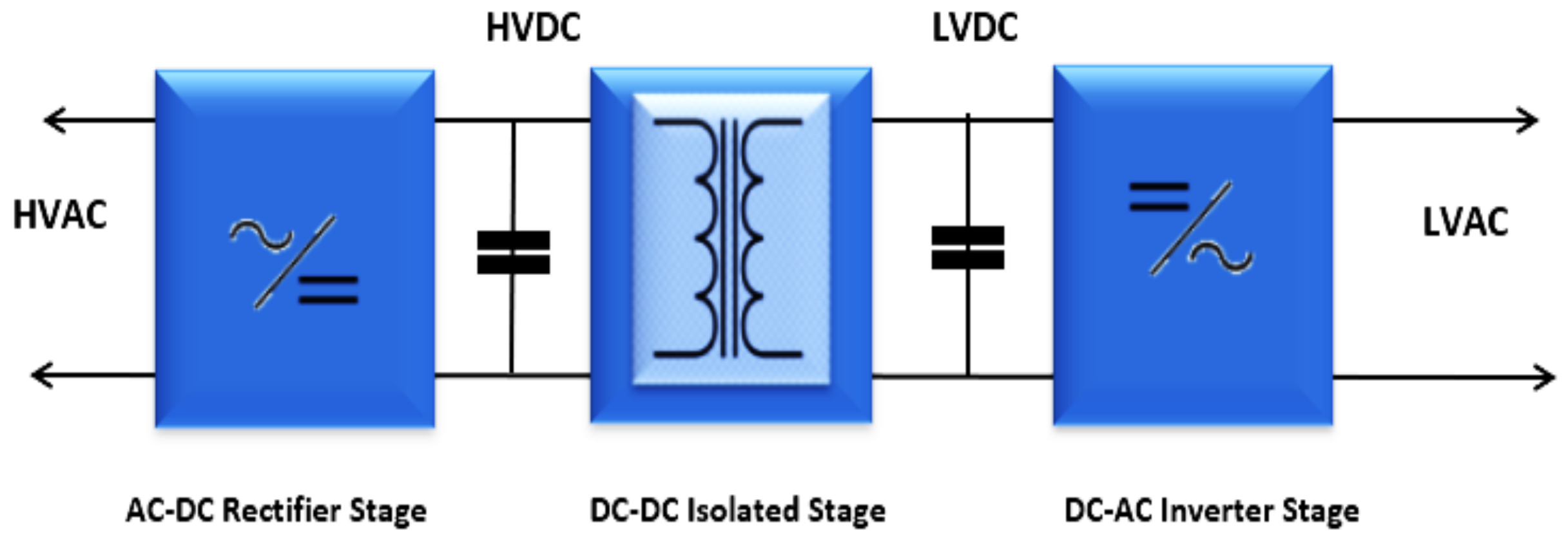


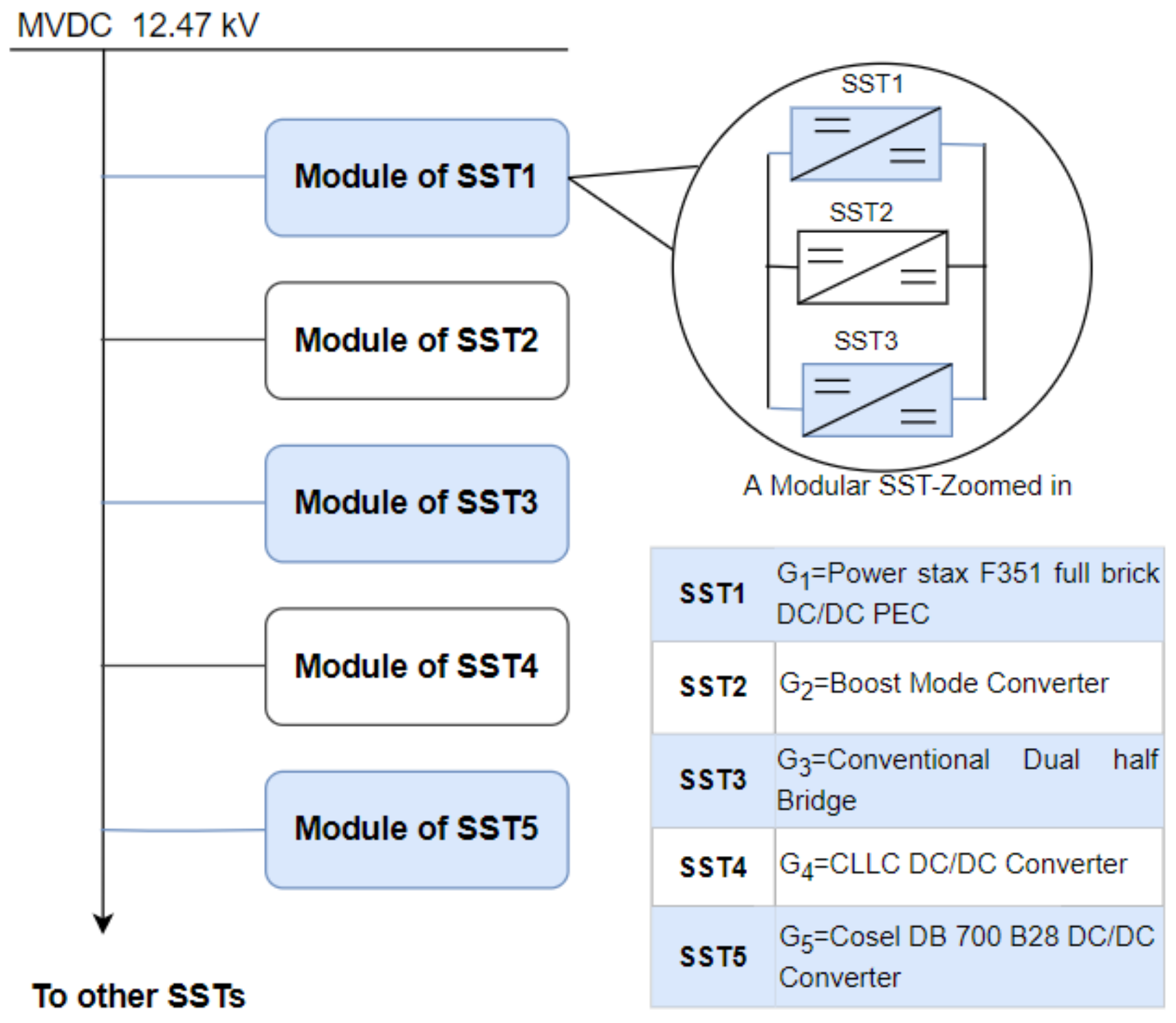
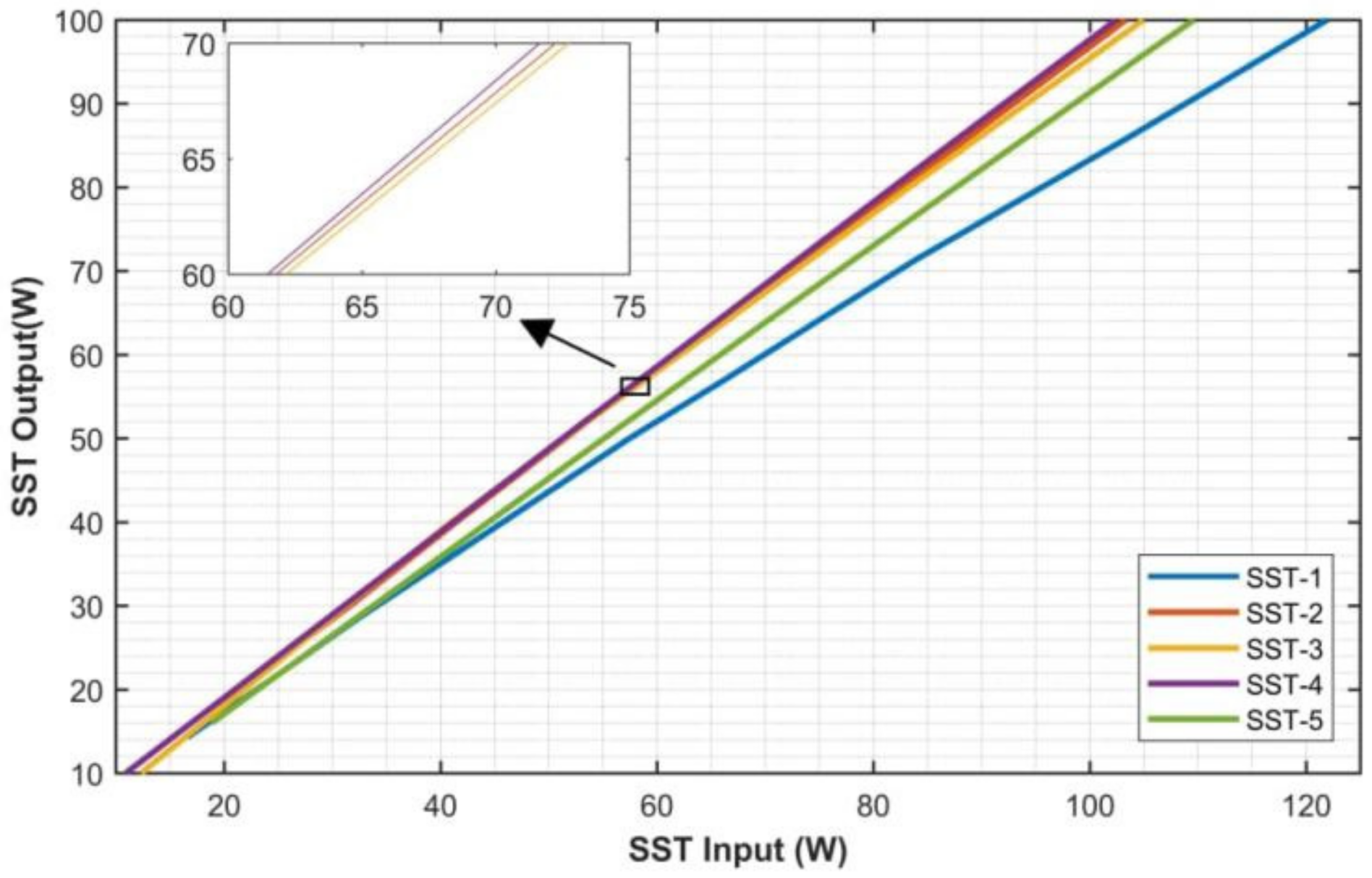

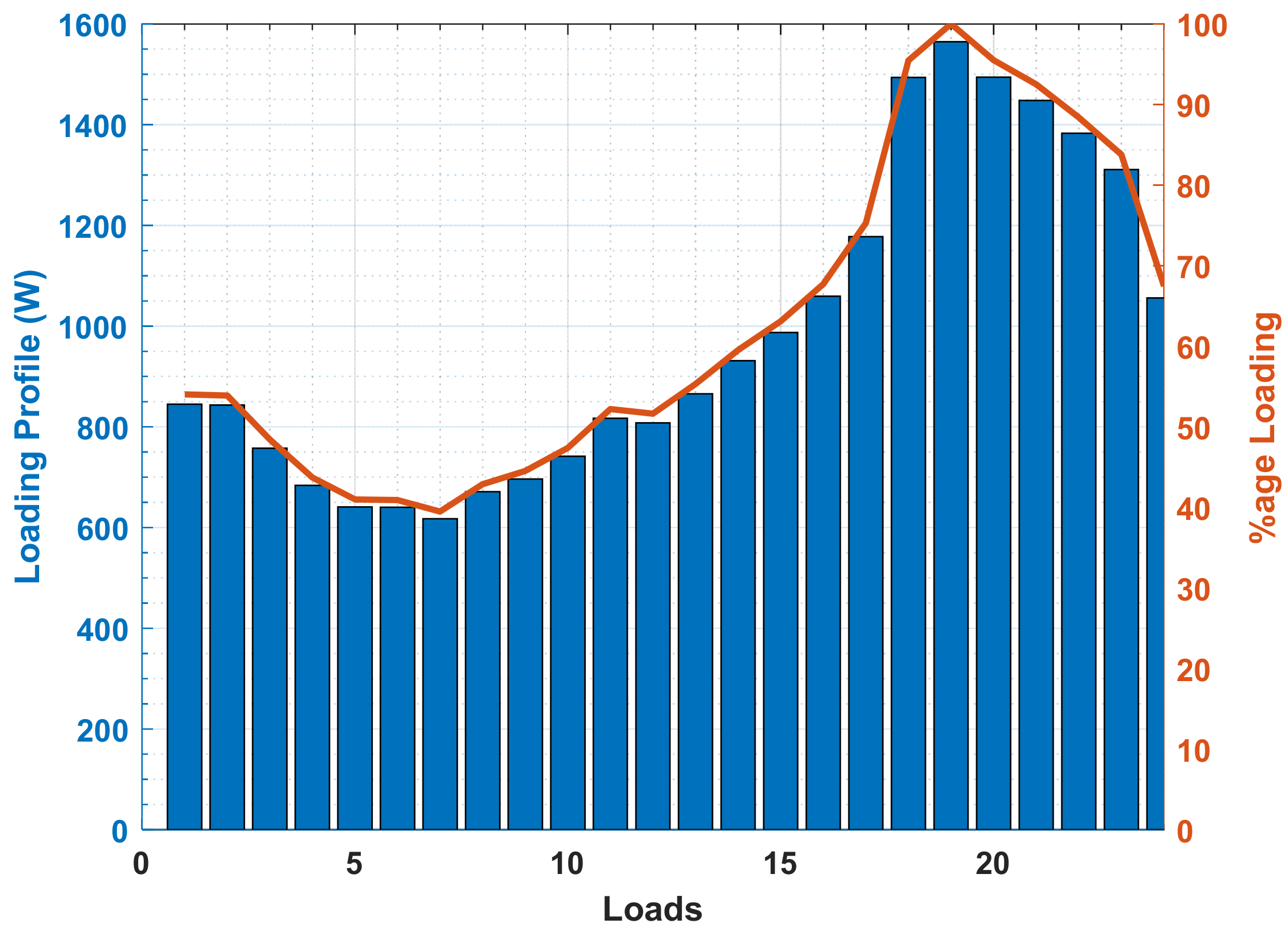


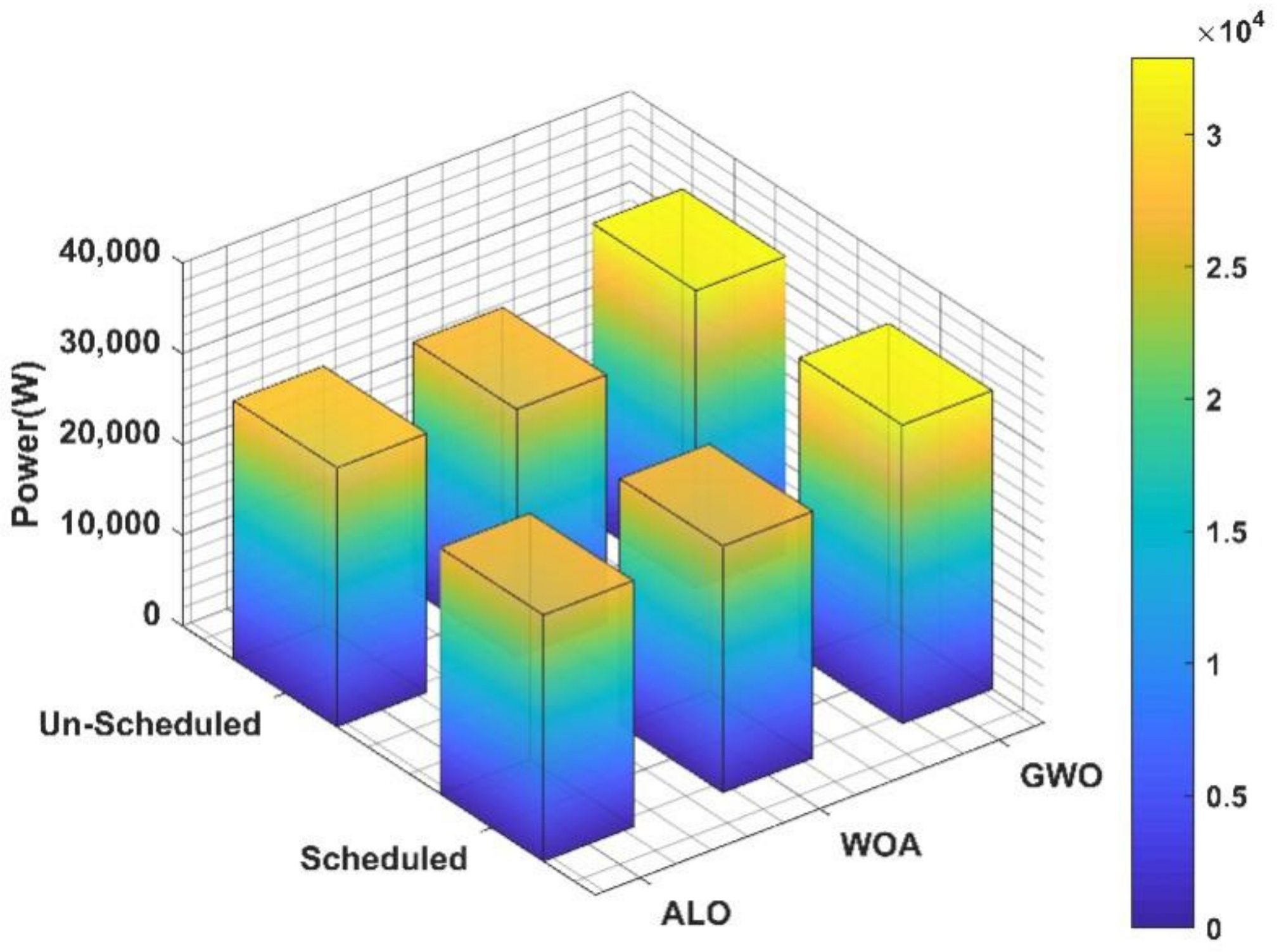
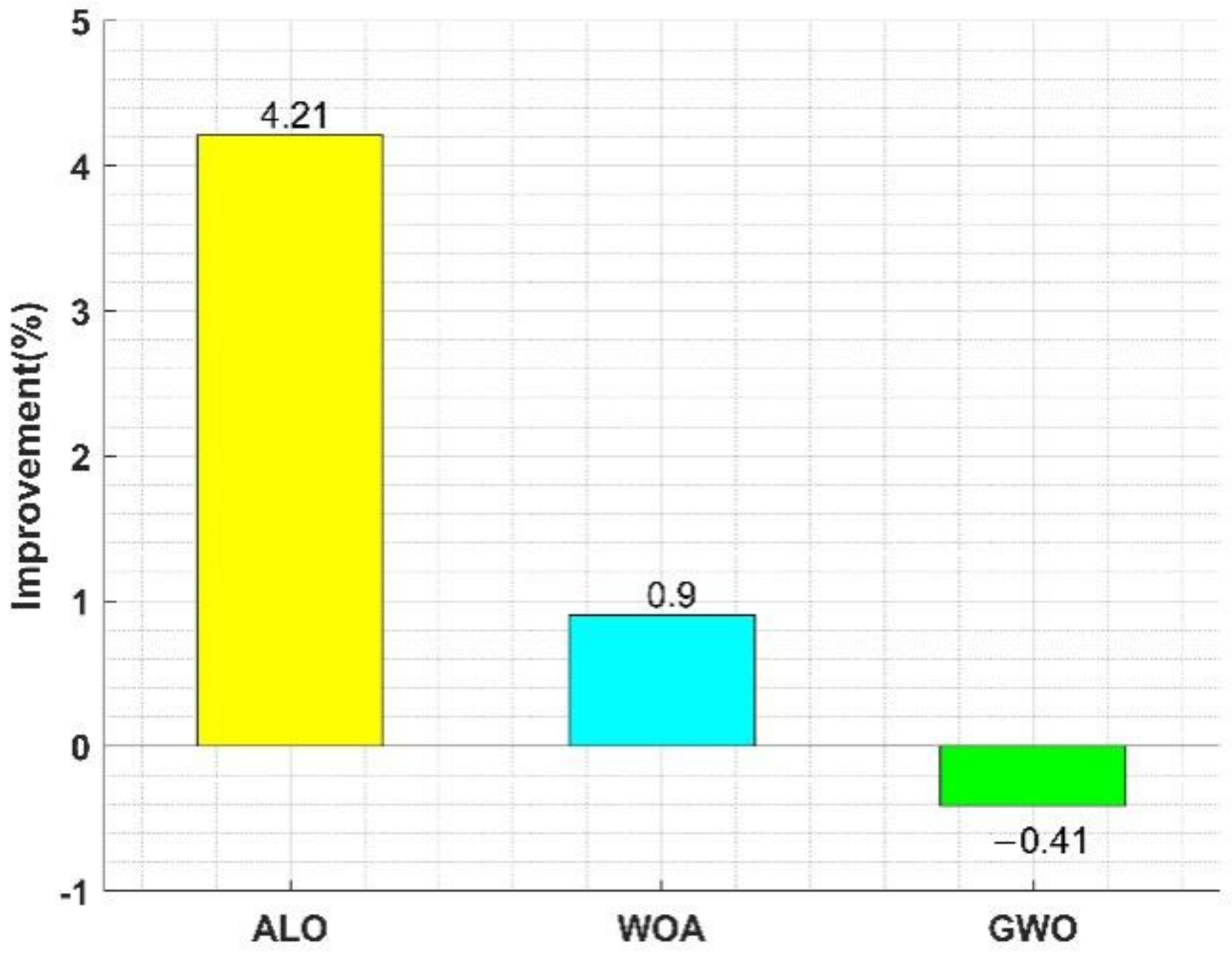
| SST Configuration Input/Output | α | β | γ | Pmin | Pmax |
|---|---|---|---|---|---|
| SST1-set of 3 | 0.0017 | 1.0409 | 1.4481 | 14.28 | 100 |
| SST2-set of 3 | 0.003 | 0.9845 | 1.5944 | 20 | 100 |
| SST3-set of 3 | 0.0010 | 0.9268 | 2.8204 | 10 | 100 |
| SST4-set of 3 | 0.0002 | 0.9991 | 0.9542 | 10 | 100 |
| SST5-set of 4 | 0.003 | 1.0438 | 2.1322 | 16 | 110 |
| Loading/Efficiency | a | b | c |
|---|---|---|---|
| SST1 | −0.0012 | 0.0780 | 85.9195 |
| SST2 | −0.0015 | 0.2206 | 89.5267 |
| SST3 | −0.0044 | 0.5768 | 79.4532 |
| SST4 | −0.0015 | 0.2108 | 90.6773 |
| SST5 | −0.0015 | 0.2444 | 81.9398 |
Publisher’s Note: MDPI stays neutral with regard to jurisdictional claims in published maps and institutional affiliations. |
© 2022 by the authors. Licensee MDPI, Basel, Switzerland. This article is an open access article distributed under the terms and conditions of the Creative Commons Attribution (CC BY) license (https://creativecommons.org/licenses/by/4.0/).
Share and Cite
Mughees, M.; Sadaf, M.; Erteza Gelani, H.; Bilal, A.; Saeed, F.; Chowdhury, M.S.; Techato, K.; Channumsin, S.; Ullah, N. Comparison of Efficiency-Based Optimal Load Distribution for Modular SSTs with Biologically Inspired Optimization Algorithms. Electronics 2022, 11, 1988. https://doi.org/10.3390/electronics11131988
Mughees M, Sadaf M, Erteza Gelani H, Bilal A, Saeed F, Chowdhury MS, Techato K, Channumsin S, Ullah N. Comparison of Efficiency-Based Optimal Load Distribution for Modular SSTs with Biologically Inspired Optimization Algorithms. Electronics. 2022; 11(13):1988. https://doi.org/10.3390/electronics11131988
Chicago/Turabian StyleMughees, Mariam, Munazza Sadaf, Hasan Erteza Gelani, Abdullah Bilal, Faisal Saeed, Md. Shahariar Chowdhury, Kuaanan Techato, Sittiporn Channumsin, and Nasim Ullah. 2022. "Comparison of Efficiency-Based Optimal Load Distribution for Modular SSTs with Biologically Inspired Optimization Algorithms" Electronics 11, no. 13: 1988. https://doi.org/10.3390/electronics11131988
APA StyleMughees, M., Sadaf, M., Erteza Gelani, H., Bilal, A., Saeed, F., Chowdhury, M. S., Techato, K., Channumsin, S., & Ullah, N. (2022). Comparison of Efficiency-Based Optimal Load Distribution for Modular SSTs with Biologically Inspired Optimization Algorithms. Electronics, 11(13), 1988. https://doi.org/10.3390/electronics11131988









